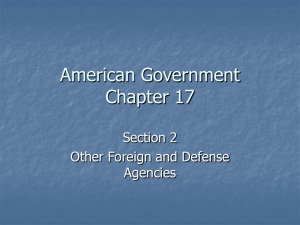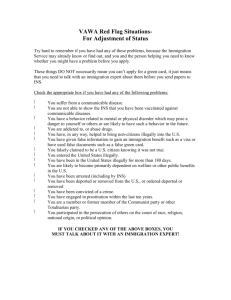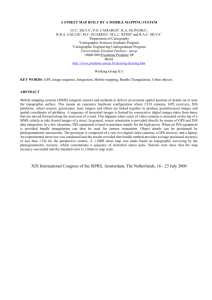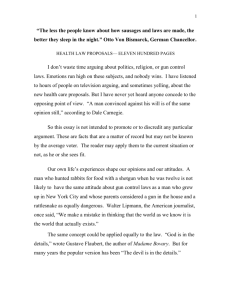injunction
advertisement
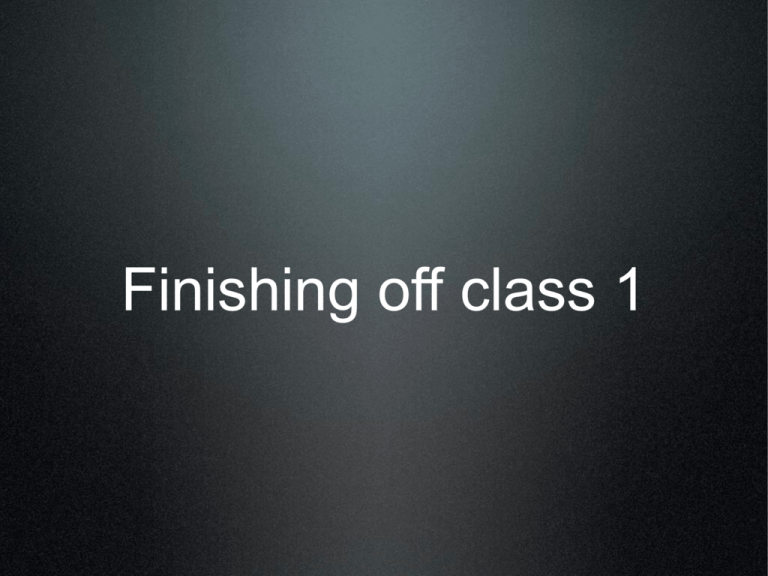
Finishing off class 1 A quick summary • ‘INS would take AP’s hot news stories about World War I battles from publicly distributed New York newspapers that subscribed to the AP service. INS would then telegraph the story to the West Coast to Hearst newspapers, which would print the stories, sometimes ahead of the West Coast AP newspaper subscribers. Thus, INS appropriated hot news stories that had been gathered by AP at great expense and effort. There was usually no copyright infringement, for there was usually no copying of the exact words of an AP dispatch; rather there was an appropriation of the underlying factual information.’ What’s wrong with that? • AP had three complaints, this was only one of them • AP did not gather War news at great expense and effort, it just digested press briefings. Does this affect whether news is ‘property’? The three complaints • INS had bribed a telegraph operator to pass on confidential AP news items • INS took AP bulletins from a Hearst paper which subscribed to AP • INS took published AP news from early East Coast editions What did AP want? • An injunction to stop INS copying in the future. (An interim injunction). • A binding precedent that news is ‘property’ or at least that it is protected by law in some way • What’s the difference? Why both? Precedent • Every decided case contributes to the body of case law or precedent, but .... • ... the first case to decide a particular legal issue is especially important. It is the first precedent on that point • Other courts later will probably (perhaps must) follow it. Depends on status of previous court in hierarchy Injunction • An injunction is binding on a specific party as a result of a court decision • INS was subjected to an ‘interim’ or ‘preliminary’ injunction, i.e. pre-trial • Injunction binds INS specifically, on the facts of the case. Precedent sets rule of law binding (in principle) in future cases against anyone Chicago days • AP was based in Chicago until 1900, and incorporated in state of Illinois • Stone, then editor of the Chicago Daily News, was frequently pirated by the McMullen brothers, owners of the rival Post and MaiL A crisis in Serbia • ‘The men, young and old, go through the streets shouting for bread, cursing the rich for not coming to their aid. A few days ago the mayor of the provincial town of Sovik issued a proclamation ending with the ominous words: “Er us siht la Etsll iws nel lum cmeht”(the municipality cannot aid).’ No crisis after all • “Er us siht la Etsll iws nel lum cmeht”(the municipality cannot aid). • “The McMullens will steal this sure.” • And they did. What about the others? But not all one way • Tribune Co. v. Associated Press, 116 F. 126, 127(C.C.N.D. Ill.1900). The court found that this controversy between “the rights of the Tribune Company to the fruits of its enterprise and expenditure under its contract arrangement with the Times, and, on the other hand, the rights of the public to the news matter thus published in the leading English newspaper” ultimately turned on copyright law. Telegraph messages • National Telegraph News Company v. Western Union Telegraph Company, 119 F. 294 (7th Cir. 1902) • Protected transient news transmitted by telegraph for tickertape machines against wire-tapping by bribed employee of Western Union Western Union • Judge Grosscup saw that Western Union was no different from a news service such as AP. Information—be it a sports score or an account of starvation in a foreign country—is itself free for anyone to gather. No one can claim an ownership interest in it at the source. But the news can be conveyed quickly across great distances only if a large infrastructure is in place. No one will build and maintain this infrastructure if the information cannot be protected at the other end. Western Union had a right to enjoin people who sought unauthorized access to the information sent out over its lines. (Baird) BoT v Christie (S Ct) • The Supreme Court adopted the same position in Board of Trade v. Christie Grain & Stock Co., 198 U.S. 236 (1905): • “The plaintiff does not lose its rights by communicating the result to persons, even if many, in confidential relations to itself, under a contract not to make it public, and strangers to the trust will be restrained from getting at the knowledge by inducing a breach of trust and using knowledge obtained by such a breach.” AP as a ‘trust’ • Inter-Ocean v Associated Press 56 N.E. 822 (What does this tell you)? • S Ct of Illinois held that AP in breach of Antitrust Acts, ordered AP to admit I-O as member • AP never did. It dissolved, and new company incorporated in New York Think about this • As a decision between the parties. Is oldAP the same as new-AP? • Does I-O have any rights against new-AP as a result of the decision? • Does decision have any useful effect as a precedent? Back to AP v INS in 1916 The three complaints • INS had bribed a telegraph operator to pass on confidential AP news items • INS took AP bulletins from a Hearst paper which subscribed to AP • INS took published AP news from early East Coast editions How to decide case? • No civil or criminal code, no statute, no (single) source of law • What about case law? i.e. ‘precedents’ • First, categorise and analyse the cause(s) of action, but bear in mind the ultimate remedies AP sought 1: Bribery • Criminal law? Perhaps, but are we interested? • Not much. Why not? Little point in prosecuting individuals. • What we want is: civil c/a; against INS as such; giving rise to injunction 1 and 2: Interference • There is a tort of interference with contract which was well-established • How useful in complaints 1 and 2? • What are its shortcomings? • On the facts of INS v AP? • In the long term, from AP’s point of view? 1 and 2: Confidence • There is also an equitable doctrine of breach of confidence • How useful in complaints 1 and 2? • What are its shortcomings? • On the facts of INS v AP? • In the long term, from AP’s point of view? 1 and 2: Where are we? • How useful would it have been to win complaints 1 and 2 individually? • Would this have stopped INS copying War news in the near future? • Would it have delivered the precedent AP and Stone wanted? • What can we do about complaint 3? What about copyright? • Remember the case about the London Times? • Stone’s Chicago paper had been allowed to copy news items from the Times, although another Chicago paper had paid for them. How so? Copyright • US law has had provision for copyright since the original constitution • Congress has power to legislate for protection of ‘writings’ of authors • One effect is to pre-empt inconsistent action by the states Copyright, US, 1916 • Were AP news items protected by copyright? Two problems • Copyright was not automatic. It depended on registration and ‘notice’ • Copyright did not effectively protect purely factual material, except against word-for-word copying Copyright, US, 1916 • So copyright did not benefit AP. Was that the end of the story? • No. Copyright policy was that writings which were not registered before publication,entered the public domain and could be freely copied The copyright problem • Copyright could not benefit AP because impossible to register news items in time, before publication • Treating news items as ‘property’ on any other basis looked like defying Congress by creating a sort-of-copyright, where no copyright ought to exist The way out • Supreme Court wanted to protect AP’s news items for reasons of fairness and abstract justice, and/or social policy • But cannot create a true property right in news, because that that would be a copyright in disguise The way out • Result: treat copying as act of unfair competition. AP’s right then effective against INS and competitors, but not against public and world at large. Hence it is not a true property right • Where does this come from? Where from? • NOT from Copyright Act or Constitution (more later ...) • Partly by taking existing precedents one step further; partly from inherent power of common law courts (not just S Ct) to create new rights and obligations as part of common law Look at INS Supreme Court decision again INS v AP, Pitney J: •‘The right of the purchaser of a single newspaper to spread knowledge of its contents ... may be admitted; but to transmit that news for commercial use, in competition with complainant—which is what defendant has done and seeks to justify—is a very different matter.’ INS v AP, Pitney J •‘[D]efendant ... is taking material that has been acquired by complainant as the result of organization and the expenditure of labor, skill, and money, and which is salable by complainant for money, and ... is endeavoring to reap where it has not sown, and by disposing of it to newspapers that are competitors of complainant’s members is appropriating to itself the harvest of those who have sown.’ INS v AP, Pitney J •‘Stripped of all disguises, the process amounts to an unauthorized interference with the operation of complainant’s legitimate business precisely at the point where the profit is to be reaped, in order to divert a material portion of the profit from those who have earned it to those who have not; with special advantage to defendant in the competition because of the fact that it is not burdened with any part of the expense of gathering the news.’ INS summed up • No absolute ‘property’ exists in news • Action lay against INS because it was a competitor, hence action is for ‘unfair competition’ • Does same principle apply more generally? How is this different? • But is this really copyright ‘by the back door’? • Motivation ‘reaping without sowing’ is very like that for copyright. So is economic rationale • Does calling it ‘unfair competition’ make enough difference? How about this? • ‘The law of copyright rests on a very clear principle: that anyone who by his or her own skill and labour creates an original work of whatever character shall, for a limited period, enjoy an exclusive right to copy that work. No one else may for a season reap what the copyright owner has sown.’ (UK HoL, Designers Guild case) Cheney v Doris • Case in the Second Circuit Court of Appeals. (1929) 35 F.2d 279 • Cheney were silk fabric manufacturers, every season they would introduce new designs. Only a few of these were successful, the rest flopped. This was too unpredictable to make protecting each design individually cost-effective • Doris copied only the best-selling designs Cheney v Doris • ‘Of the cases on which the plaintiff relies, the chief is International News Service v Associated Press, …. Although that concerned another subjectmatter—printed news dispatches—we agree that, if it meant to lay down a general doctrine, it would cover this case; at least, the language of the majority opinion goes so far.’ Cheney v Doris • ‘We do not believe that it did. While it is of course true that law ordinarily speaks in general terms, there are cases where the occasion is at once the justification for, and the limit of, what is decided. This appears to us such an instance; we think that no more was covered than situations substantially similar to those then at bar. The difficulties of understanding it otherwise are insuperable. We are to suppose that the court meant to create a sort of commonlaw patent or copyright for reasons of justice. Either would flagrantly conflict with the scheme which Congress has for more than a century devised to cover the subject-matter.’ Remember? • Two formulations of INS v AP • Protection of ‘hot news’ under law of unfair competition • General basis for doctrine of ‘misappropriation’ in common law • What happens next? Post-INS timescale • INS to Cheney • Cheney to Erie v Tomkins • Erie to Sears/Compco • Sears to California v Goldstein • Goldstein to 1976, and present End of class 2

